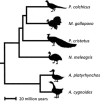Variation in promiscuity and sexual selection drives avian rate of Faster-Z evolution
- PMID: 25689782
- PMCID: PMC4737241
- DOI: 10.1111/mec.13113
Variation in promiscuity and sexual selection drives avian rate of Faster-Z evolution
Abstract
Higher rates of coding sequence evolution have been observed on the Z chromosome relative to the autosomes across a wide range of species. However, despite a considerable body of theory, we lack empirical evidence explaining variation in the strength of the Faster-Z Effect. To assess the magnitude and drivers of Faster-Z Evolution, we assembled six de novo transcriptomes, spanning 90 million years of avian evolution. Our analysis combines expression, sequence and polymorphism data with measures of sperm competition and promiscuity. In doing so, we present the first empirical evidence demonstrating the positive relationship between Faster-Z Effect and measures of promiscuity, and therefore variance in male mating success. Our results from multiple lines of evidence indicate that selection is less effective on the Z chromosome, particularly in promiscuous species, and that Faster-Z Evolution in birds is due primarily to genetic drift. Our results reveal the power of mating system and sexual selection in shaping broad patterns in genome evolution.
Keywords: Faster-Z evolution; effective population size; genetic drift; sexual selection.
© 2015 John Wiley & Sons Ltd.
Figures





Similar articles
-
Postcopulatory sexual selection reduces Z-linked genetic variation and might contribute to the large Z effect in passerine birds.Heredity (Edinb). 2019 May;122(5):622-635. doi: 10.1038/s41437-018-0161-3. Epub 2018 Oct 29. Heredity (Edinb). 2019. PMID: 30374041 Free PMC article.
-
Temporal genomic evolution of bird sex chromosomes.BMC Evol Biol. 2014 Dec 12;14:250. doi: 10.1186/s12862-014-0250-8. BMC Evol Biol. 2014. PMID: 25527260 Free PMC article.
-
Positive Selection Underlies Faster-Z Evolution of Gene Expression in Birds.Mol Biol Evol. 2015 Oct;32(10):2646-56. doi: 10.1093/molbev/msv138. Epub 2015 Jun 10. Mol Biol Evol. 2015. PMID: 26067773 Free PMC article.
-
Sex chromosomes and speciation in birds and other ZW systems.Mol Ecol. 2018 Oct;27(19):3831-3851. doi: 10.1111/mec.14537. Epub 2018 Mar 23. Mol Ecol. 2018. PMID: 29443419 Review.
-
The genetic basis of traits regulating sperm competition and polyandry: can selection favour the evolution of good- and sexy-sperm?Genetica. 2008 Sep;134(1):5-19. doi: 10.1007/s10709-007-9162-5. Epub 2007 Jul 7. Genetica. 2008. PMID: 17619174 Review.
Cited by
-
Comparative transcriptomics and gene expression divergence associated with homoploid hybrid speciation in Argyranthemum.G3 (Bethesda). 2023 Sep 30;13(10):jkad158. doi: 10.1093/g3journal/jkad158. G3 (Bethesda). 2023. PMID: 37477910 Free PMC article.
-
Phenotypic sexual dimorphism is associated with genomic signatures of resolved sexual conflict.Mol Ecol. 2019 Jun;28(11):2860-2871. doi: 10.1111/mec.15115. Epub 2019 Jun 5. Mol Ecol. 2019. PMID: 31038811 Free PMC article.
-
A Study of Faster-Z Evolution in the Great Tit (Parus major).Genome Biol Evol. 2020 Mar 1;12(3):210-222. doi: 10.1093/gbe/evaa044. Genome Biol Evol. 2020. PMID: 32119100 Free PMC article.
-
Turtle Insights into the Evolution of the Reptilian Karyotype and the Genomic Architecture of Sex Determination.Genes (Basel). 2020 Apr 11;11(4):416. doi: 10.3390/genes11040416. Genes (Basel). 2020. PMID: 32290488 Free PMC article. Review.
-
Sex-linked genomic variation and its relationship to avian plumage dichromatism and sexual selection.BMC Evol Biol. 2015 Sep 16;15:199. doi: 10.1186/s12862-015-0480-4. BMC Evol Biol. 2015. PMID: 26377432 Free PMC article.
References
-
- Altschul SF, Gish W, Miller W, Myers EW, Lipman DJ (1990) Basic local alignment search tool. Journal of Molecular Biology, 215, 403–410. - PubMed
-
- Andersson M (1994) Sexual Selection. Princeton University Press, New Jersey, USA.
-
- Axelsson E, Smith NGC, Sundstrom H, Berlin S, Ellegren H (2004) Male‐biased mutation rate and divergence in autosomal, Z‐linked and W‐linked introns of chicken and turkey. Molecular Biology and Evolution, 21, 1538–1547. - PubMed
-
- Axelsson E, Hultin‐Rosenberg L, Brandström M, Zwahlen M, Clayton DF, Ellegren H (2008) Natural selection in avian protein‐coding genes expressed in brain. Molecular Ecology, 17, 3008–3017. - PubMed
Publication types
MeSH terms
Grants and funding
LinkOut - more resources
Full Text Sources
Other Literature Sources

